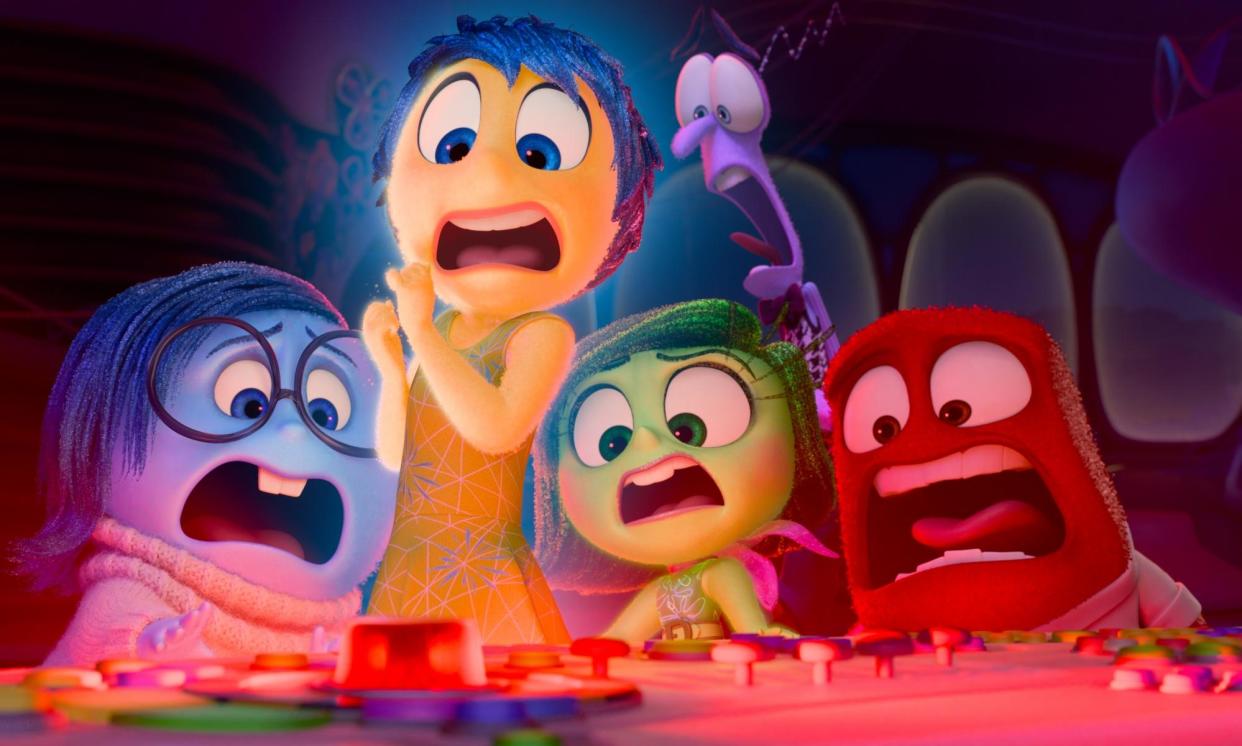Inside Out 2: Joy v Anxiety, puberty, and the big secret – discuss with spoilers

Related: Joy for Pixar as Inside Out 2 smashes expectations – and box office records
Inside Out 2 has far exceeded expectations at the box office over the weekend, shattering records and massively boosting morale across the film industry. So, we know a lot of people went to see it, and that a lot of them in the US liked it (it got an A grade from CinemaScore, which tracks exiting punters’ reactions).
The elephant in the room is that the original Inside Out was a masterpiece. A best-part-of-a-decade-in-the-making masterpiece: immaculately structured, insightful, tight, funny and very moving. Matching that is an almost impossible task – right? We want your thoughts on how the new movie measures up to the old, and stands on its own terms.
Here’s a few pointers on places your mind might like to go.
New emotions – and new voices
Anxiety – the jittery muddle of orange – voiced by Maya Hawke is clearly the key new recruit into headquarters. Is she too close to Fear, or are their differences (imagined peril v real threat) far enough apart? Likewise, do incoming Envy and old hand Disgust share DNA? Does Embarrassment have enough to do – ditto Ennui and Nostalgia?
Amy Poehler, Lewis Black and Phyllis Smith are back as Joy, Anger and Sadness, but a pay dispute means Mindy Kaling and Bill Hader have been replaced. How much does that matter?
New concepts
As well as core memories and personality islands, Inside Out 2 introduces core beliefs that coalesce, via new twangy strings that form from a memory soup, into a sense of self. When Joy is in charge, this vocalises as “I’m a good person”; what comes in its place when Anxiety is at the wheel is “If I’m good at hockey, I’ll make friends” and “I’m not good enough”. Is this dismantling of such a core personality part intelligible? How’s about the sar-chasm and stream of consciousness ? Did they work?
Hockey and high school
There’s really a lot of puck action in this new one, including that climactic scrimmage. If you live in North America: did it feel accurate? If you don’t: did you follow it, and could you appreciate why it all felt so crucial to Riley?
Just as the first film saw her move house and school, so too the sequel’s engine is the prospect of having to make new friends in an alien environment. How plausible did Riley’s reactions feel? And why did her parents not appear to hear the revelation about her friends being assigned to another school on the drive up to hockey camp?.
Boys, boys, boys
The move to high school coincides with the onset of puberty for Riley – which possibly feels quite late. The girls are shown eager to hang on to childlike goofiness and – aside from Mount Crushmore – one of the key aspects of adolescence remains unaddressed. Sexuality is entirely absent in the film: Riley lusts after no one of either gender, and no one ever brings up such a thing. Her girl-crush on the older hockey player is exclusively nervous and aspirational.
More than that, real-world (as opposed to inner voice world) men and boys are almost nonexistent in the film; the role played by Riley’s parents is diminished in parity with the size of their island – but did you miss that element?
Forgotten friends
Joy has a small Bing Bong model in her sleeping quarters, but that’s the only glimpse we get of Riley’s long-lost imaginary friend, and the source of some of the first film’s most amusing and moving moments. Instead we have, consigned to the vault of secrets, Bloofy, a grainy 2D, fourth-wall addressing preschool pup, along with Pouchy, a bottomless bumbag full of bad ideas – dynamite. Along with them is perhaps the new film’s most inspired creation: Lance Slashblade, a stilted video game hero with perpetually blown hair and a disappointing power move. How did these compare to everyone’s favourite elephant/candyfloss/cat/dolphin hybrid?
Panic stations
While the first film is always engaging, riding wild highs and lows and skirting real existential terror, it’s also a relaxed watch. Inside Out 2, less so, as Anxiety takes the wheel and becomes a literal whirl which threatens to dismantle a child from within. As we see within Riley’s mind as she has her panic attack, there’s something positively Cronenbergian about visually unpacking her mental disintegration and the remarkably swift switch from sweet child to angry, violent proto-criminal.
Losing Joy
Related: Amy Poehler: ‘If we want young people to fix everything, why do we make fun of them?’
It isn’t just Riley who has a breakdown: even Joy flips, twice – once lashing out at her fellow emotions for their continued griping, the second time weeping as she realised there may no longer be a place for her. Too much for the kids? Or just the right level of relatability for their parents?
The big secret
Remember the big ogre-like lad stashed in the vault with Bloofy, Pouchy and Lance? Who promises “Not yet” when Joy asks what he’s harbouring? Some especially wild internet rumours had speculated it might be that Riley is gay – which would have been a striking way for Pixar to out her. My son and I were the only ones at the (almost full) Saturday teatime screening in Wood Green to stay for the big post-credits reveal, which turns out to be … that Riley once burnt a rug. This felt … anticlimactic.

 Yahoo Movies
Yahoo Movies 
